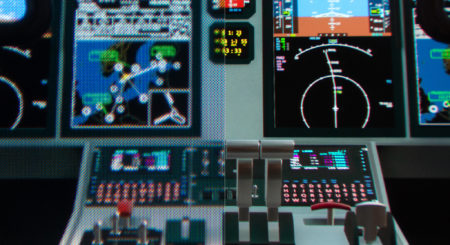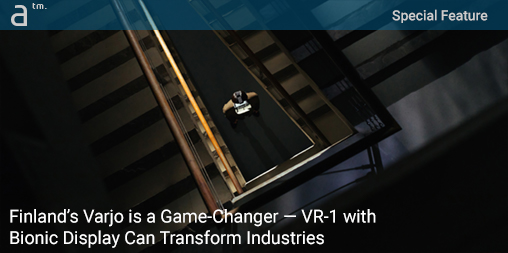AR ISN’T GOING TO CRUSH the world of VR anytime soon if ever, thanks to Varjo’s VR-1 headset.
But it turns out this virtual reality device began as a “mixed reality” (MR) project when the Finnish company got started a few years ago. What transpired in the shift with Varjo is an interesting tale in the value of challenging assumptions and careful listening to early beta partners.
“We founded the company with the principle that we wanted to do mixed reality,” said Varjo Chief Product Officer Urho Konttori. But things took a different course once they started touring around to different companies in 2017. “We would show them our human-eye resolution VR but also the mixed reality too, and it was pretty interesting to see their reactions. Most companies said, ‘whoa, that’s super cool what you are doing with the mixed reality, but we don’t know quite what to do with it.’ ”

Varjo VR-1 virtual reality headset with human-eye resolution Bionic Display. The device from Finland is now available worldwide.
It turns out that those early potential customers saw massive value in a VR device that operated at “human-eye” resolution, something that sets the VR-1 apart from its competitors in the market.
The VR-1 — History and Development
Architosh first wrote about the Varjo VR-1 back in 2017 when the company came out of stealth mode. While the company seems young, its founders were already involved in both shipping and lab-only technologies while at Nokia both before and after Microsoft’s acquisition of the famed mobile phone maker. Some of these technologies going back to Nokia were the roots behind Microsoft’s eventual Hololens mixed-reality product.
“Once Microsoft discontinued operations in Finland, those founders who had Microsoft positions were offered positions on the West coast, but we decided to stay here,” said Konttori. Varjo’s founders (there are four) all had backgrounds involving some combinations of Nokia, Intel, Microsoft or Nvidia. Encouraged by the several local Scandinavian tech companies, including Umbra 3D, they met up with investors and presented their initial vision and technology for the company. The day they showed their prototype technology was the day they walked away with one million dollars in seed funding. “After just 15 minutes of discussing with them they backed us,” said Konttori.
Once Microsoft discontinued operations in Finland, those founders who had Microsoft positions were offered positions on the West coast, but we decided to stay here.
After going to work on a mixed reality device the company committed to focus on a device that reached “human-eye” resolution. Aided by their experience at Nokia working with high-megapixel cameras and screens handling the input side turned out to be not that difficult. But what about output? What about the displays?
At that time the displays inside the Oculus Rift and HTC Vive were 50x lower resolution than the human eye. “We had been discussing matters with most of the display manufacturers and knew their road maps,” added Konttori. “Based on that we concluded it was going to take ten years until we would have human-eye resolution displays.” The early company challenged their assumptions and asked if they could shortcut that timeframe.

Varjo VR-1 (right) versus the HTV Vive (left). With “human-eye” resolution VR-1 provides transformative workflow change across numerous industries, importantly aerospace simulation and training.
“That’s how we ended up inventing the Bionic Display concept,” said Konttori. They worked for roughly one year on the technology, doing a lot of patents to protect their inventions and then in the summer of 2017 they completed the product development. The Varjo Bionic Display technology is unique in the world of VR headsets. It features a combination of two types of display technology working in unison together via innovative software engineering. One display is a 1920×1080 low-persistence micro-OLED and the other display a 1440×1600 low-persistence AMOLED.
Uniquely, the Bionic Display also features an angled glass plate that works as an optical combiner that merges the two displays into a single image. One display, the micro-OLED display is providing the retina level (human-eye) resolution. “The software is blending both the normal and human-eye displays all through the display area, not just at the edges of the display,” said Konttori. Because both displays are fundamentally different technology, they also have small differences in color rendering in addition to their resolutions.
“As a designer, you care about two things,” adds Konttori, “you need to see each and every detail as they appear in the real world, but you also need to have color calibration and color accuracy. The only way to do that is to actually blend them (displays) at every pixel in the display area. It turns out to be a nontrivial thing to accomplish, but it works out remarkably well in our finished product.”
next page: The VR-1—For Enterprises





Reader Comments
Comments for this story are closed